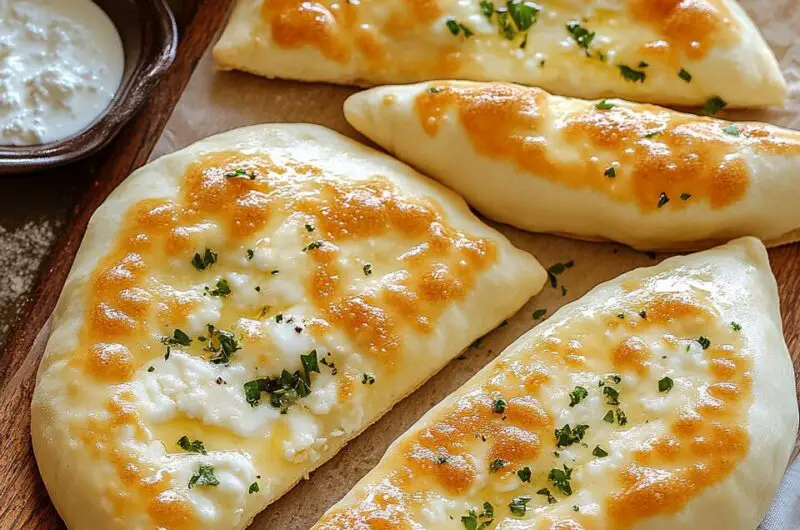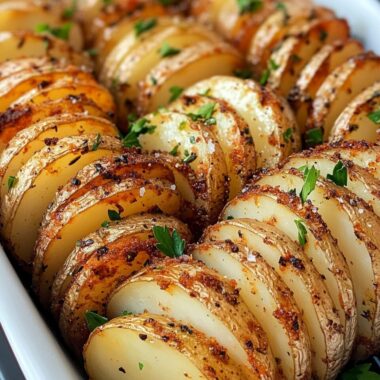These Cheese Fatayer are a beloved Middle Eastern pastry, traditionally served in Lebanese homes and bakeries. With their tender dough, savory cheese blend, and herbaceous accents from parsley and mint, they offer a rich burst of flavor in every bite. Often served as part of a mezze platter, these golden triangles are as beautiful as they are delicious. Ideal for brunches, snacks, or family dinners, Cheese Fatayer are versatile and incredibly satisfying. You can customize the filling with your favorite cheeses or even add a pinch of za’atar for extra zing. They’re baked to golden perfection and enjoyed both warm or at room temperature perfect for sharing or meal prepping ahead.
Full Recipe:
Ingredients:
-
2 ½ cups all-purpose flour
-
1 teaspoon instant yeast
-
1 teaspoon sugar
-
½ teaspoon salt
-
3 tablespoons olive oil
-
¾ cup warm milk
-
1 egg (for brushing)
Filling:
-
1 ½ cups Akkawi cheese (or mozzarella), shredded and soaked to reduce salt
-
½ cup feta cheese, crumbled
-
2 tablespoons chopped fresh parsley
-
1 tablespoon chopped mint
-
1 teaspoon za’atar (optional)
Directions:
-
In a large mixing bowl, combine the flour, yeast, sugar, and salt.
-
Add the olive oil and warm milk to the dry ingredients. Mix until a soft dough forms.
-
Knead the dough for 8–10 minutes until smooth and elastic. Cover and let rise in a warm place for about 1 hour or until doubled in size.
-
While the dough is rising, prepare the cheese filling by mixing the Akkawi and feta cheeses with chopped herbs and za’atar (if using).
-
Preheat oven to 375°F (190°C). Line a baking sheet with parchment paper.
-
Once the dough has risen, divide it into small balls (about golf ball size).
-
Roll each ball into a flat circle, place a spoonful of filling in the center, and fold into a triangle or boat shape, pinching edges to seal.
-
Place on the baking sheet. Brush tops with beaten egg for a golden finish.
-
Bake for 18–20 minutes or until golden brown and cooked through.
-
Let cool slightly before serving.
Prep Time: 15 minutes | Cooking Time: 20 minutes | Total Time: 1 hour 35 minutes
Kcal: 210 kcal | Servings: 12 fatayer
Discovering Cheese Fatayer: A Beloved Middle Eastern Pastry
Cheese Fatayer is one of those comforting, soulful dishes that instantly transports you to the heart of the Middle East. Popular across Lebanon, Syria, Jordan, and Palestine, these savory stuffed pastries are a staple in Levantine cuisine. Often served as part of a mezze spread, Cheese Fatayer is loved for its flaky dough, warm cheesy center, and the herbal notes of parsley and mint that lift its flavor profile. But what makes this pastry so special, and why has it stood the test of time?
Let’s explore the cultural roots, variations, and culinary charm of this Middle Eastern gem.
The Origins and Cultural Significance
Fatayer is a general term used in Arabic cuisine to describe small pies or turnovers filled with various savory ingredients such as spinach (sabanekh), ground meat (lahm bi ajeen), or in this case, cheese. The word “fatayer” itself is derived from the Arabic root “f-t-r,” which is related to pastries or pies.
The tradition of making fatayer dates back centuries, with origins in the Levant region where home-baked breads and pastries are part of everyday life. Cheese Fatayer, in particular, became a favorite due to the abundance of dairy products in the region and the importance of breadmaking in Arab households.
In many Middle Eastern families, these pies are prepared in large batches for holidays, Ramadan iftars, or family gatherings. You’ll often find them in local bakeries, stacked in golden piles behind glass counters, fresh out of the oven.
What Makes Cheese Fatayer Unique?
What sets Cheese Fatayer apart from other savory pastries around the world is the combination of its components. The dough is typically soft and pillowy, made with basic pantry ingredients like flour, yeast, oil, and milk. This base creates a neutral, fluffy canvas that lets the cheese filling shine.
The filling is usually a mix of white cheeses like Akkawi, Nabulsi, or Feta, all of which are brined and slightly salty. These cheeses are often soaked before using to mellow their saltiness. The richness of the cheese is balanced with fresh herbs most commonly parsley and mint which bring a brightness that keeps the pastry from feeling too heavy.
In addition to herbs, many versions of Cheese Fatayer include a sprinkle of za’atar, a spice blend made from thyme, sumac, sesame seeds, and salt. This adds a tangy, nutty depth that transforms the flavor into something distinctly Levantine.
Regional and Modern Variations
Although the basic structure of Cheese Fatayer remains the same, regional adaptations and modern twists add diversity to the dish.
1. Triangle vs. Boat Shapes
Traditional Cheese Fatayer is usually shaped into a triangle by folding the dough over the filling and pinching the edges. In some areas, especially in Palestine and Jordan, the pies are formed into small “boats” or open-faced ovals. This variation shows off the melty cheese top and adds a rustic charm.
2. Different Cheese Blends
Some cooks prefer a mix of mozzarella and feta for a gooey, slightly tangy filling. Others incorporate halloumi or ricotta depending on what’s available. For a creamier, more indulgent version, a spoonful of labneh (strained yogurt) is sometimes added to the cheese mixture.
3. Spiced or Sweetened Dough
While traditional fatayer dough is plain, modern recipes sometimes add a pinch of sugar or a dash of black seed (nigella sativa) or even turmeric to the dough for added aroma and character.
How to Serve Cheese Fatayer
Cheese Fatayer is incredibly versatile when it comes to serving. Whether you’re planning a Middle Eastern feast or looking for a hearty snack, these pastries can easily adapt to the occasion.
1. As Part of a Mezze Platter
In traditional Levantine dining, mezze is a spread of small dishes served at the beginning of a meal. Cheese Fatayer pairs beautifully with hummus, baba ghanoush, labneh, and fresh vegetables. Serve them warm for the best texture and flavor.
2. Perfect for Brunch or Picnics
Cheese Fatayer are excellent choices for brunch, potlucks, or picnics. They travel well, taste great at room temperature, and can be made in advance. Pair them with a mint tea or a citrusy salad for a balanced meal.
3. Kid-Friendly and Freezer-Friendly
These pastries are a hit with kids because of their cheesy center and soft texture. They also freeze beautifully just bake a batch, let them cool, and store in a freezer-safe container. Reheat in the oven to restore their original fluff and crisp.
Nutritional Profile and Health Tips
While Cheese Fatayer isn’t exactly a low-calorie food, it can be made healthier with a few simple tweaks:
-
Use whole wheat flour for added fiber.
-
Reduce the cheese or use part-skim varieties.
-
Add vegetables like spinach, grated carrots, or chopped olives to increase nutritional value.
-
Brush with olive oil instead of egg wash for a dairy-free finish.
For those with dietary restrictions, the dough can be made gluten-free using alternative flours, and dairy-free cheese alternatives work well in the filling with a little trial and error.
The Role of Cheese Fatayer in Celebrations
In Middle Eastern homes, Cheese Fatayer often makes an appearance during holidays, particularly during Ramadan and Eid. During Ramadan, these pastries are part of the iftar meal, the evening meal to break the fast. Their comforting and filling nature makes them ideal after a long day of fasting.
Similarly, they are popular during Eid al-Fitr and Eid al-Adha gatherings, where large batches are baked and shared with family and friends. Some families even pass down heirloom dough and filling recipes from generation to generation.
Making Cheese Fatayer at Home
One of the joys of Cheese Fatayer is that they’re relatively easy to make at home even for beginner bakers. The dough requires minimal kneading, and the filling can be prepped in minutes. The real artistry lies in shaping the fatayer, a process that’s meditative and fun, especially when done in a group or with family.
To make the most of your homemade fatayer experience:
-
Work with fresh herbs and high-quality cheese.
-
Let the dough rise properly for that fluffy, bakery-style texture.
-
Shape the pastries tightly to avoid leaking cheese during baking.
-
Always serve them warm or reheat gently in the oven.
Conclusion:
Cheese Fatayer is more than just a stuffed pastry it’s a culinary expression of Middle Eastern hospitality, tradition, and family. With its tender dough and fragrant cheese filling, it captures the essence of comfort food while offering endless possibilities for customization. Whether you enjoy it with a cup of tea on a quiet afternoon or serve it to guests at a festive dinner, this dish never fails to satisfy.
So, the next time you’re looking for a recipe that’s as fulfilling to make as it is to eat, consider Cheese Fatayer. It’s a beautiful way to bring the warmth of the Levant into your kitchen one golden triangle at a time.








